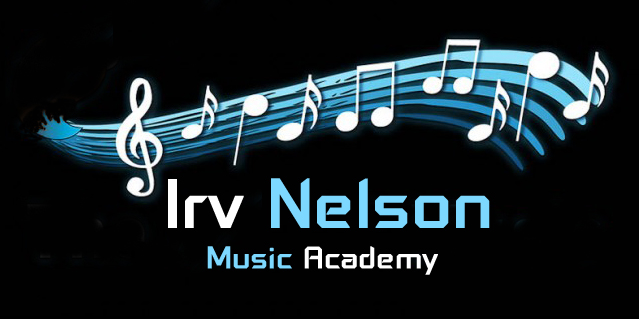
Contemporary Music Instruction and Mentoring
Selecting a Microphone
Microphones and speakers are the PA system
components that are MOST important for getting a good
sound. You may or may not have control of what
speakers are used, depending on the performance
situation. But you can control what microphone is
used. For any vocalist it is a good idea to have your
own microphone, because you never know what you'll run into
when someone else is providing the PA system.
Recommending a microphone is a bit like recommending a good car to buy. There are a plethora of choices, in a wide variety of price ranges, for a wide variety of situations (e.g., studio vocal recording, live vocal performance, instruments, guitar amps, drums, etc.)
There are two basic microphone types: condenser and dynamic. An understanding the differences between these types is the first thing you need to understand in order to make a wise decision on what mic you should buy.CONDENSER MICS:
They sound fantastic. For this reason they
are used extensively in recording studios.
They require “phantom power” from the mixer. (They will not
work with a mixer that cannot provide phantom power)
They can be very large (for example, those giant mics used
in recording studios are condenser types)
They can also be extremely small (for example, all of those
tiny headset mics are condenser mics)
They are not generally used for live performance because
they are prone to feedback
They are fragile (if one falls onto the floor you hold your
breath... because it may be dead)
They are unable to handle extremely loud volume, so they are
not good for drums or guitar amps
They are generally more expensive than dynamic mics
The best ones sound almost as good as condenser mics (but cheap ones sound horrible!)
They do not require phantom power, so they will work with any mixer
They are extensively used for live music performance situations
Some of them are very good at rejecting feedback
They are tough and reliable
They have more “proximity effect” (increasing bass response as you get closer)
The best ones can handle extremely loud volumes without distorting
They are generally less expensive than condenser mics
VOCAL MICS
Mics for live vocal performance come in both
varieties. Personally, I have some of both. I
love the sound of my old AKG C900 condenser mics
(below).
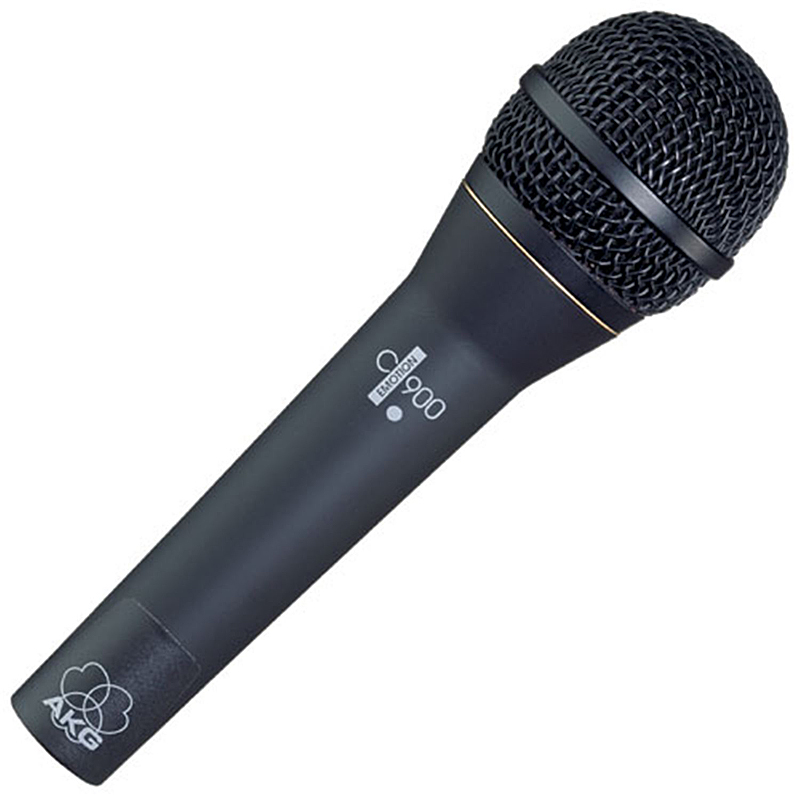
For quiet, low volume gigs, nothing sounds
better. They are crystal clear, and have fantastic
detail and presence. But they feed back like crazy at
high volume events, and they are not rugged at all.
That's why for live performance, I recommend
dynamic mics to my students. They are much more
rugged, and will hold up longer under the rigors of gigging.
Also, they will work with any PA system, they don't need
phantom power, and the best ones are excellent at rejecting
feedback.
For live vocal performance, the old "standard" dynamic mic that has been around since the mid 1960s is the Shure SM58 (below). A lot of people still recommend the SM58 mic. I don't.
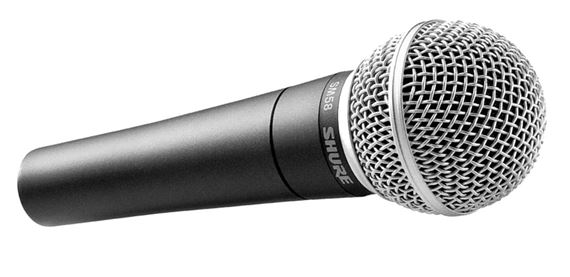
It is true that the SM58 is the mic by which all others are judged and compared. It is also the mic that nearly all pro sound techs use for live performance -- STILL... even after all these years!! -- for three reasons. First, they are cheap (they sell for about $100). Second, they are predictable. Every sound engineer has used them hundreds of times and knows how they are going to sound. Finally, they are almost indestructible. You can literally pound nails into a board with these mics and they will still work.
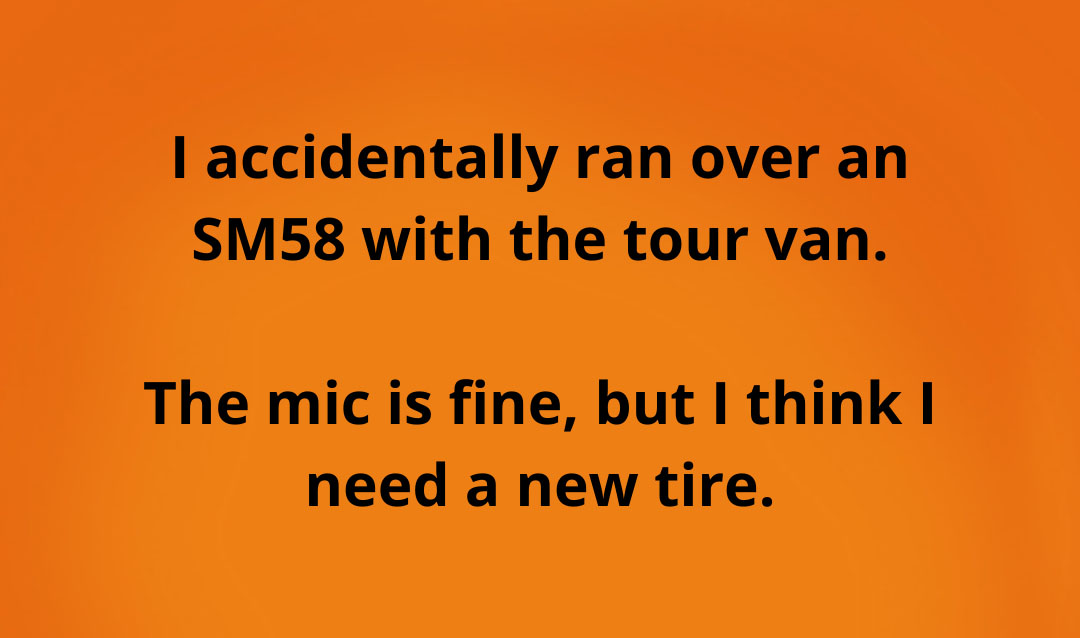
Yes, the SM58 was by far the best mic when it
first came out -- and yes, it’s still a decent mic -- but technology has improved in
the last 50 years! There have been better mics
available for a long time, and today there are MUCH better
mics available. To be blunt, the SM58 is a
dinosaur. Anyone who still thinks the SM58 is the best
mic out there either has no idea what they are talking about
or has a tin ear. Do a side by side comparison and
you'll be amazed at the difference. SM58's (and SM57's
which are the exact same mic without the pop screen) are a
complete waste of money. DON'T BUY an SM58,
and don't listen to people who tell you that you should.
My favorite dynamic vocal mic right now is the
Sennheiser e935 (below). It
sounds almost as good as a condenser mic. It is
excellent at rejecting feedback and has a very high gain
before feedback. Sonically it has a very organic
"presence" that
sounds extremely natural. I consider it to be
the best all around vocal mic for live performance. It is
priced at $200 and I HIGHLY recommend it. https://www.sweetwater.com/store/detail/E935--sennheiser-e-935-cardioid-dynamic-vocal-microphone
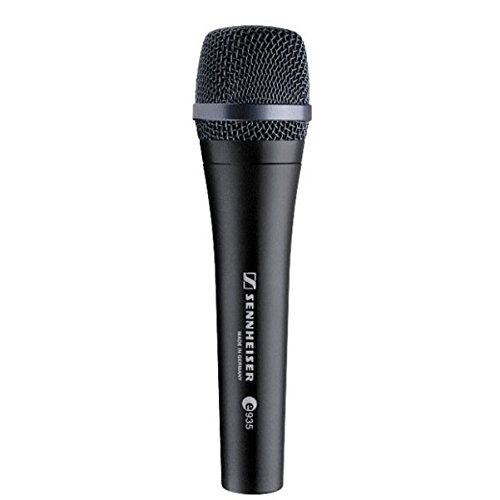
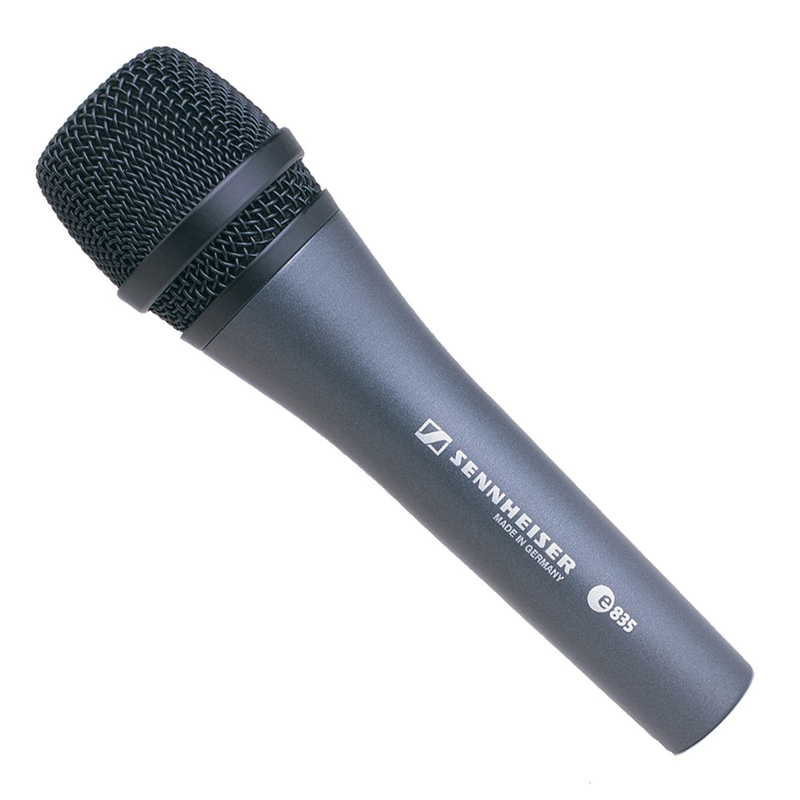
Sweetwater.com
sometimes has a deal where you can purchase
three of them for about $250 https://www.sweetwater.com/store/detail/E835S3Pack--sennheiser-e-835-s-live-vocal-microphone-with-on-off-switch-3-pack
WIRELESS VOCAL MICS
I understand the desire of lead singers who are not playing instruments to be able to hold their microphone and wander around the stage without the constraint of a cord. With old style analog wireless systems, noise, hiss, distortion, bad frequency response, compression, interference, and other problems made using a cordless a VERY bad idea. Modern digital technology has reduced these problems, but inexpensive cordless mics still sound horrible, because most of them use cheap analog-to-digital processors and lousy transducers (that's the microphone part of the microphone/transmitter combination).
If you spend many hundreds of dollars you can get a
cordless mic that approaches the quality of the corded mics
discussed above. For example, Sennheiser sells an
excellent wireless system that allows you to choose between
different microphone capsules
https://www.sweetwater.com/store/detail/EWDHHSet-Q16--sennheiser-ew-d-skm-s-wireless-handheld-base-system-q1-q6
and you can get one that sounds just like an
e935 corded mic https://www.sweetwater.com/store/detail/MMD935BK--sennheiser-mmd-935-1-bk-microphone-capsule-for-wireless-transmitter
It will sound nearly identical to a $200 e935
mic on a cord. But that system costs about
$800. For that reason, I usually encourage
students who don't have a big budget to use high quality
corded mics. They have the best sound, they are
cheaper, and they are more reliable.
If you really have your heart set on a wireless
mic, there is one system that I can recommend in the $400
price range (or $200 range if you already have a good
mic.) First buy an e935 mic for $200, then spend the
remaining $200 on a separate transmitter and receiver for
it.
The best affordable transmitter/receiver I'm aware
of is the Xvive Audio U3 (below). I have not used it
personally, but Sweetwater recommends it. The specs
sound good: it has 24 bit processing, excellent frequency
response, low noise, low distortion, plenty of channels, and
both the transmitter and receiver run off rechargeable batteries
that charge with a USB cord, like a smartphone. You
just plug the transmitter into the end of your microphone
instead of a cord, and plug the receiver into the snake or
the mixer, instead of a cord. This system sells for
$200 at Sweetwater https://www.sweetwater.com/store/detail/U3Set--xvive-audio-u3-microphone-wireless-system.
(It has 5 stars on reviews. By way of
comparison, the Sennheiser XSW-D also has 5 stars,
and costs $320. And the Boss WL-30XLR sells for $250
and only has 4 stars.)
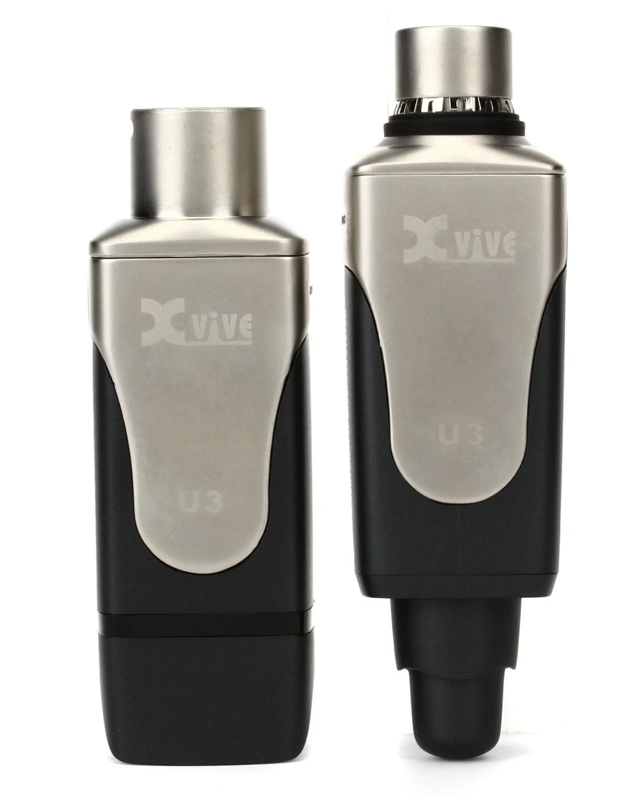
$220 for a Sennheiser e935 plus a cord
or
$400 for a Sennheiser e935 and an Xvive Audio U3
or
$800 for a Sennheiser MMD 935-1 BK and a Sennheiser EW-D SKM-S Wireless Handheld Base System
All of these will sound great, but the best sounding and most reliable of all will be the $220 option.
If you use a cordless system, always bring a mic cord to the gig, and always have it stretched out, ready to plug into the mic and the snake, on a moment's notice. If you forgot to charge the battery, or if the battery is going bad, or a dozen other reasons, wireless systems can die during the set, even if they worked during the sound check.
MICS
FOR ACOUSTIC GUITARS
In the studio, never
plug in your acoustic guitar. Always use an
excellent condenser microphone on it, and it will sound
WAY better on the recording than it would plugged in.
But for live
performance, it is the opposite. Never mic an
acoustic guitar at a gig! It will sound lousy and
the PA will start squealing with feedback.
Instead, save up and buy an "acoustic electric" guitar
with built-in electronics.
If you have an
acoustic electric guitar, there are two accessories you
will need.
First, even with built in electronics, acoustic guitars
can still cause feedback in the PA system, especially at
high volume gigs, and in venues with hard surfaces that
reflect sound. If you get feedback using your
acoustic electric guitar on stage, the easiest and
cheapest way to eliminate feedback is to plug the sound
hole with a d'Addario Screeching Halt Acoustic Guitar
Feedback Suppressor (below). It will ruin the
unplugged acoustic sound of the guitar, but it will not
have much effect on the amplified sound. They only
cost about $6 https://www.sweetwater.com/store/detail/ScreechHalt--daddario-planet-waves-screeching-halt-acoustic-guitar-feedback-eliminator
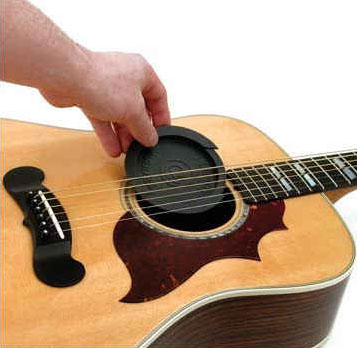
Second, you will need a quality guitar cord. (LINK HERE and scroll down for information and recommendations for quality guitar cords and also about cordless guitar systems.) Third, you should have a DI box (the above link also has information about what DI boxes are for, and a recommendation for a DI box).
MICS
FOR ELECTRIC GUITARS
There are
several brands of modern digital modeling guitar
pedalboards that imitate tube guitar amps. If
you have one of these, you can plug directly into a
PA system from the XLR balanced outputs ("DI"s), and
you do not need a microphone for your electric
guitar. The audience will hear the electric
guitar in the PA system, and you can hear it in the
monitors.
On the opposite
end of the spectrum, for players who are purists and
want the very best electric guitar sounds, only a
real tube amplifier will do. If you have a
tube amplifier and play in a band, you need to use a
microphone in front of the cabinet to send a signal
to the mixer.
My personal
preference is halfway between these two
alternatives. I dislike the pedalboards
because they just don't sound very good. Also,
part of the live performance experience is being
able to hear my guitar separately from the monitors
and to be able to tweak the volume and tone during
the performance. But I also don't love tube
amps anymore, because I want a wider variety of
sounds than a tube amp can give, and also I don't
want the inherent problems of tube amps (inability
to adjust volume without affecting tone,
unreliability, and very heavy weight.) That's
why I use a digital modeling amp. It sounds
90% as good as a tube amp, with half the weight, and
all of the advantages of a pedalboard (large variety
of sounds, reliability, etc).
Modern digital
modeling guitar amps have balanced XLR direct
outputs built right into the amp that enable you to
plug a mic cord straight into the amp, just like a
digital pedalboard does, so no microphone is
needed. However, in a side by side comparison,
it almost always sounds better to stick a microphone
in front of the amp rather than using the built in
DI outputs. That is because part of the sound
shaping comes from the speaker and the cabinet.
If a
professional sound company is doing the sound, they
will have a mic that they can put on your amp, but
you never know what you're going to get.
(Believe it or not, most of these guys are still
using SM57's, which are dinosaurs.) So it's
nice to have your own mic. You can use just
about any dynamic mic (not condenser mic!), but a
purpose built mic will have the best sound.
The best sounding guitar amp mic is the Sennheiser
e906 (below) https://www.sweetwater.com/store/detail/e906--sennheiser-e-906-supercardioid-dynamic-instrument-microphone.
The Sennheiser e609 is a less expensive mic ($120)
that looks nearly identical to the e906 and sounds
pretty decent https://www.sweetwater.com/store/detail/E609Silver--sennheiser-e-609-silver-dynamic-supercardioid-guitar-microphone.
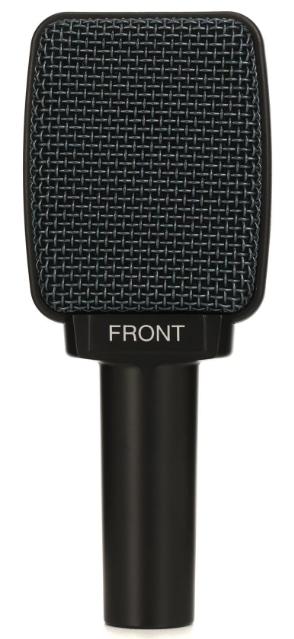
Bass guitars are very different from electric guitars. No bass players want to use a vintage tube powered bass amp anymore. They are not loud enough, they are ridiculously heavy, and they don't sound better. In fact, they actually sound worse than solid state amps in most situations. That's why many bass players these days just plug straight into the PA with a DI, and are perfectly happy with hearing themselves through the monitors. For those who still want their own amp and speaker cabinet onstage (including me), modern bass amps have XLR jacks ("DI's") built into the back, and the bass sounds absolutely fine to the audience through those outputs. In fact, the bass sounds better through those outputs than it does with a microphone in front of the cabinet. So bass players don't need a microphone.
MICS FOR KEYBOARDS
If you are using a real vintage Rhodes or Wurlitzer electric piano played into a tube amp, or a Hammond B3 organ with a Leslie speaker, you will need good mics to get that wonderful tone into the PA. There are several high volume instrumental mics good for that purpose. But hardly anyone uses real vintage keyboards anymore except in a top tier pro level recording studio. Since this is very rare, I won't bore you with what mics are best.
Modern professional stage keyboards have those amazing vintage sounds, as well as fantastic 9' grand pianos, strings, and hundreds of other sounds, digitally sampled. They sound 90% as good as the original instruments, they are much lighter and smaller, and are more reliable. Professional stage keyboards all have balanced XLR outputs, and you will be absolutely fine just plugging mic cords into those jacks and running them to the PA.
In large venues, drums always need to be mic'd. If a professional sound company is running the sound, they will have a good set of drum mics for you to use. But if you are playing with your own band PA system, you need to buy some drum mics. Even in small venues, you need at least a kick mic and a snare mic. In large venues, in a band with electric guitars, you need a full drum mic set.
Some drummers spend a bunch on their drums and cymbals and drum heads, and then buy a cheap set of mics. They end up sounding to the audience like the trap set was bought at WalMart. Don't go cheap on drum mics. I haven't researched drum mics in recent years so I don't have a recommendation, but plan on spending at least $500 for a decent set of 4-5 mics, or preferably up to $1,000 or more for a high quality set of 7-8 mics. How many mics do you need? Well, kick drum, snare, each tom, hi hat, and overheads for cymbals requires 7-8 mics in most trap sets. The kick mic is the most expensive. A quality kick drum mic is $200+ just by itself. The other mics are slightly less expensive, but the price does add up. Buying the mics in a set instead of individually cuts the price almost in half.
MIC CORDS AND SNAKES
LINK HERE for a discussion of mic cords, and for my recommendations for quality, inexpensive cords and snakes.